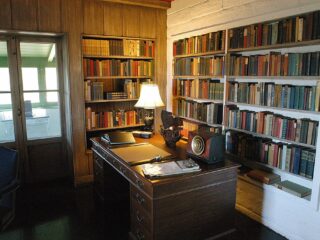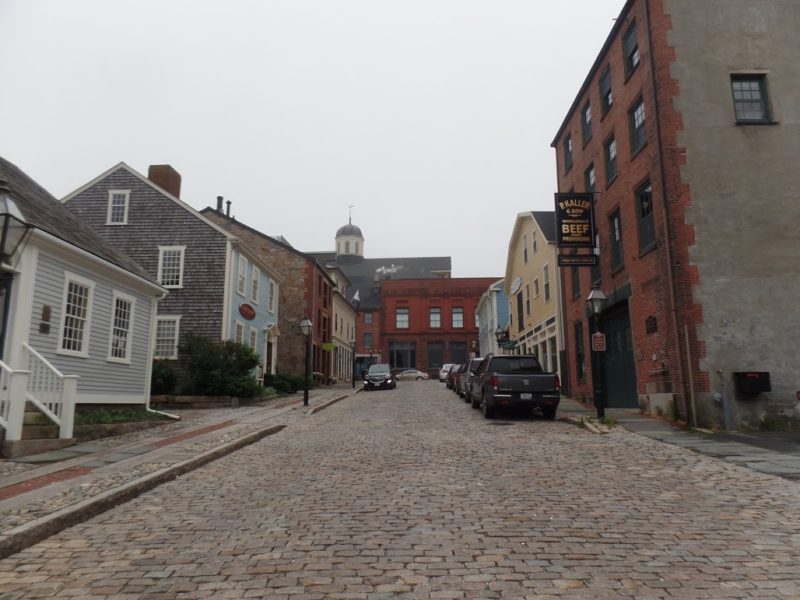
By Erin Levens
Climbing roses and big puffs of hydrangea accent the houses along the cobblestone streets of
Nantucket. An island of weathered buildings with starfish in the windows and whales on the
doors; trendy stores, cafés, coffee and ice cream shops sit alongside brick mansions bearing
semi-circular plaques to commemorate which sea captain lived in which home. Lighthouses and
waves. Seals in the breakers. Whales breaching offshore. Boats, ferries, sails, rigging,
cobblestones, shutters, Quaker meeting houses, and churches. The tininess of the Nantucket
Town. Open air shops, seagulls, and beyond the coffee mugs and T-shirts, generations of history.
Nantucket, in its diminutive glory, reflects the contradictions played out on the vast field of the
American landscape. The island has significantly disparate meanings to different people across
the socio-economic spectrum. My fascination comes from a source both obvious and unexpected.
Last summer, I sat on a beach in North Carolina and finished Moby Dick. Although I am a fearless bookworm, in this case, I had expected something ponderous, boring, and dated. What I found was a deep ocean of a novel teeming with life, comedy, history, science, stories within stories, fear, love, pain, and human nature. I fell a little bit in love with Herman Melville’s quirky brain and observational perception. He was once a crewman on the whaleship Acushnet, and I imagined him participating in daily life as a sailor all the while observing, memorizing, and internalizing everything with the eye of a writer. I needed to dive deeper into Moby Dick, and search for a little trace of Melville and his world beyond the harpoon. So I boarded a whaleship.
The last remaining whaleship, docked with her bowsprit pointing to land, floats quietly in
relative stillness. My husband and I drive to Mystic, Connecticut, to see her. Where once there
were more than 2,500 such ships, now there is one. Her name is the Charles W. Morgan, and she has sailed thousands of miles and gone further around the world than many of the people who grace her decks these days at the Mystic Seaport Museum. The ship has seen whales, their joyous breaches and leaps, misty spouts of expelled air from their blowholes, and their cruel slaughter. The sailors on these decks have smelled the intensity of a living whale, from the zoological pungency of ocean life through to the kill and on to the horrific stink of the try-pots boiling away by night, black smoke rising and wafting away over the dark ocean, the trail of moonlight paling in comparison to the roiling red flames on deck. All is quiet now.
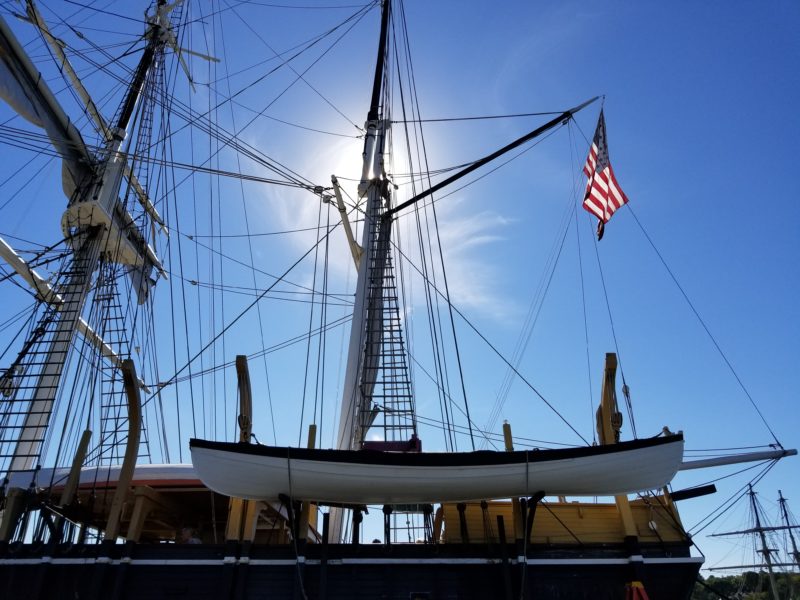
As we explore its decks, the crew materializes for me as spirits of the sea, hoisting sails, coiling
rope, cutting into a whale chained to the side of the ship or fighting off sharks having a feeding
frenzy on the fresh kill. The rookies lie nauseated and homesick in their narrow bunks at the bow of the ship, the huge mast coming up from below, passing through their quarters and shooting through the upper deck into the open sky. Throughout its 80-year whaling career, the
Charles W. Morgan’s home port was New Bedford, MA. New Bedford also happens to be the town from which both Melville and Ishmael began their whaling voyages. And so it becomes our next stop.
After a little over an hour’s drive, we stand on the cobblestones of North Water Street in New
Bedford amid nineteenth-century buildings, stores, and taverns that look as though Ishmael and
Queequeg will round the corner at any moment. From North Water Street, you can look down Centre Street or Rose Alley and see the rigging of dozens of workaday fishing boats, long liners,
clammers, and trawlers docked at the marinas exactly where whaleships, schooners, and
merchant vessels have moored for 300 years.
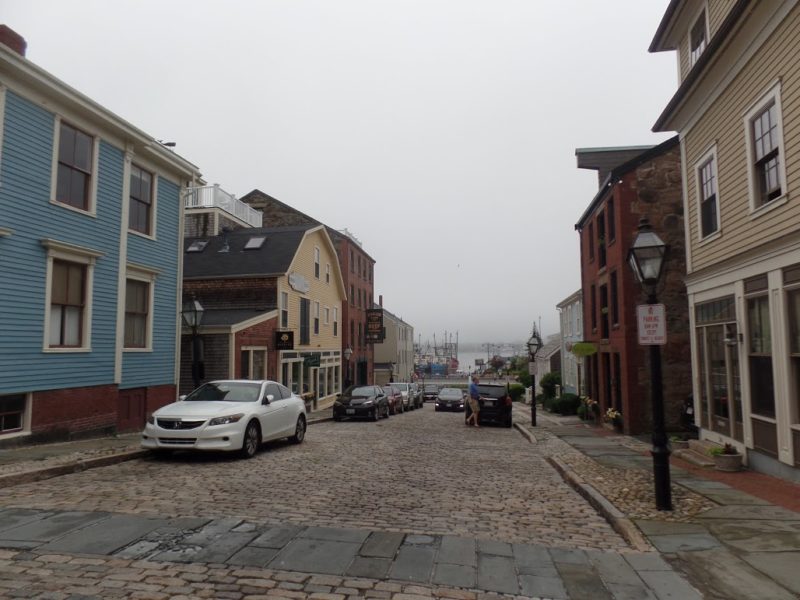 In New Bedford’s heyday as capital of the whaling industry beginning in the mid-nineteenth
In New Bedford’s heyday as capital of the whaling industry beginning in the mid-nineteenth
century, ships sailed up and down the Acushnet River between Fairhaven and New Bedford,
working, earning money, and gambling against unexpected weather, just as the modern-day
boats do. As we make our way down Centre Street toward the wharf, I mentally overlay the
rigging holding GPS modules and antennae with the wooden yardarms and masts that supported the square-rigged sails of the historic ships.
Forever on a quest to superimpose the past over the present, I can never let go of the idea that we are always on the same ground, however much it evolves and changes, as people of years past. Everywhere we walk, it is all hallowed ground that has been witness to stories thousands of years old. The parking lot of the mall, the woods behind your house, or the streets of any city are all standing on untold stories, perhaps still swirling in the mists or breezes that are stirred by the residual energy generated by place. Is the energy of the sailing ships, the harvested whales, the working men, the winds that powered their long journeys all still there somewhere shimmering, trapped in the mud of the harbor bottom, the wood of the piers, the stones of the warehouse that stands facing the Fairview Inn, once stocked with sailcloth, ledger books, barrels, provisions, and coins?
We visit the Seamen’s Bethel on Johnny Cake Hill where Melville attended a church service
which later became The Whaleman’s Chapel in Moby Dick. We walk over the cobblestones
between restored buildings and imagine Ishmael, searching for an inn on an icy, winter night.
Meeting friends for dinner in a waterfront restaurant and then walking across the parking lot to our hotel puts me in mind of Ishmael finally finding a good meal and place to sleep for the night
at the fictional Spouter Inn, just steps away from where we are now.
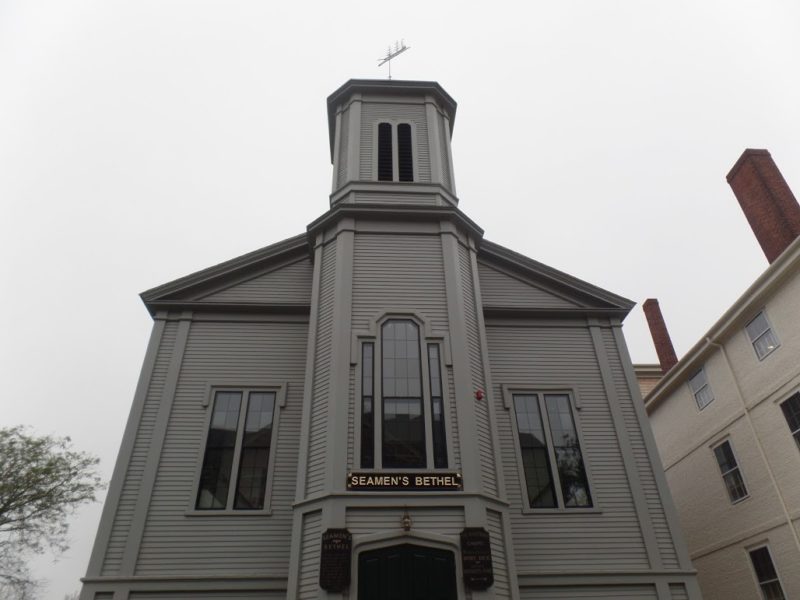
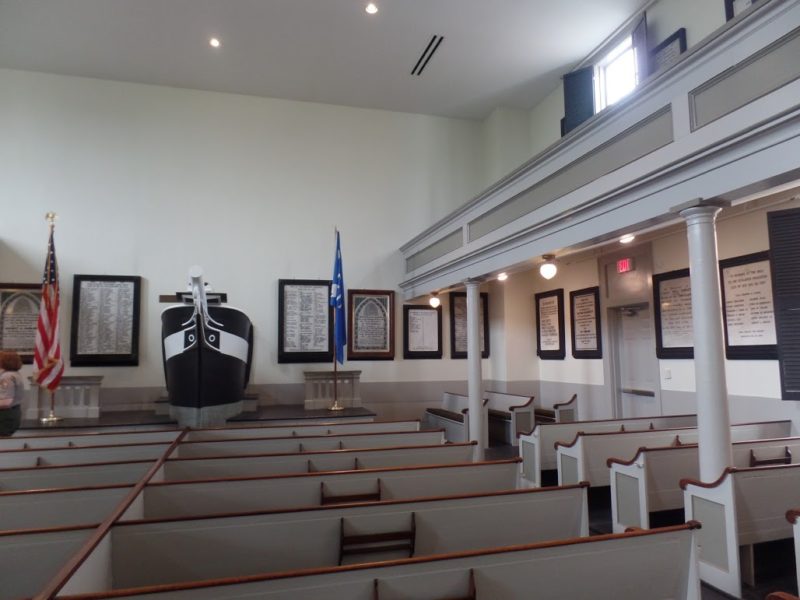
The next morning, we board the ferry to Nantucket in a flurry of children holding barking dogs
on tangles of leashes, wedding guests in party mode, shoppers with bags of purchases from the
mainland, and parents pushing strollers and pulling suitcases up the gangway. We find seats, and it feels like we are on a very wide charter bus. It is morning and I’m grateful to see a small
counter for coffee and snacks. People read, chat, or surf their phones while kids run around, and
a young ferry worker helps untie the boat then runs for the snack bar to start selling. The
wedding guests buy wine spritzers, starting the celebration early.
As the ferry makes its way down the Acushnet River between the towns of New Bedford and
Fairhaven, we get up to explore, stepping over dogs and leashes in the aisle to make our way out
the back doors. We pass a small deck with outdoor seating and climb the stairs to the upper deck. What was Herman Melville’s view as compared to mine? Did our eyes see the same church
spires along the shore? In January 1841, he was twenty-one when he left New Bedford on the
Acushnet.

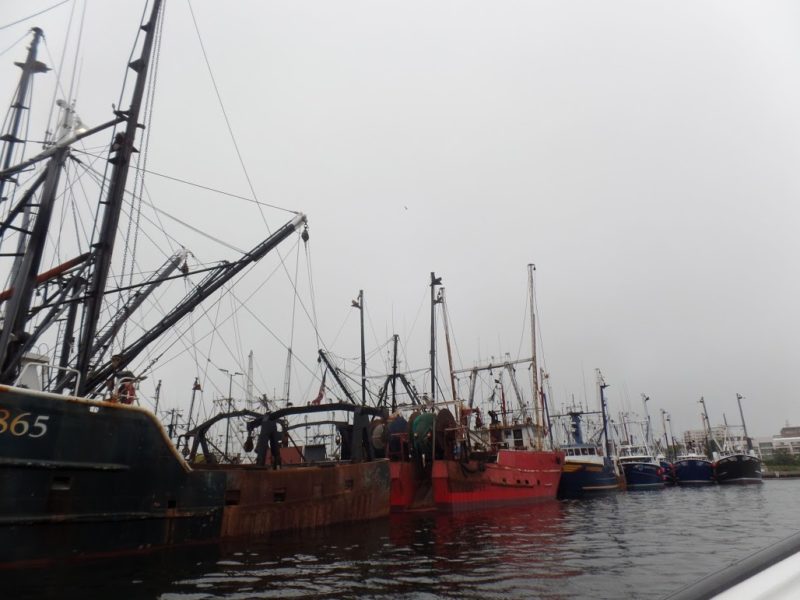
It’s early October and this is the last ferry to Nantucket from New Bedford, MA, for the season.
On the upper deck of the Seastreak, the wind slaps our faces and whips my hair into a frenzy. We have made our way to the mouth of the Acushnet River and the water opens out into Buzzards Bay. I envision Melville’s ship keeping pace with us, the bow rising and falling heavily in the chop, men scrambling up rope ladders, the first mate calling out orders. Alas, we are on a high-speed ferry and Melville’s sailing ship wouldn’t have come close to our progress.
We stay up top as we approach what looks like a collision course with solid land. What did it
look like to Melville? Was he working on sails at the time, perched in the rigging? Already
amassing ideas for writing? What did first-time sailors think as they approached the Elizabeth
Islands? They stretch from Woods Hole across Buzzards Bay like a pinball machine flipper,
seemingly blocking entry to Vineyard Sound and then open ocean. Our ferry slows and we join a
loosely-configured line of sailboats and other vessels navigating through the gap between Woods
Hole, MA, and Nonamesset Island.
After Moby Dick, I read In the Heart of the Sea by Nathaniel Philbrick and learned the story that
had sparked Melville’s imagination. A well-known tragedy at the time, the whaleship Essex
had left Nantucket on August 12, 1819, and never came back. Herman Melville was living in New
York City at the time, just eleven days old. The Essex left on a typical whaling voyage with a
crew of twenty-one, sailed halfway around the world and was pummeled by a sperm whale in the middle of the Pacific Ocean. All twenty-one crewmembers survived the initial sinking, dividing themselves up into the three small whaleboats used when chasing a whale. But due to starvation, illness, and cannibalism, only eight men from two whaleboats survived to tell the tale after eighty-nine and ninety-three days at sea. One of the men, Benjamin Lawrence, created a small length of twine while spending over three months drifting at sea with no food or water. The twine is now in the Nantucket Whaling Museum.
My desire to know who and what came before me is constant. I want to know what is authentic
and still standing, what is real and what a replica, what lies beneath what we see and where we
stand. Can we feel the ghosts? Can we feel the lingering energy? Can we be aware of any
invisible remnants like the whale DNA I envisioned existing in the original floorboards of the
whaleship Charles W. Morgan?
We arrive at Martha’s Vineyard, stop to let passengers off, and then continue on to Nantucket. Salt spray on the windows and the constant up and down of the bow remind us that we are truly in the ocean now. Nantucket is thirty miles off the coast of Cape Cod, and boats used to take an
entire day to get there. And then we are threading through the jetties leading into Nantucket
Harbor. Dogs, babies, shoppers, wedding guests, all disembark onto the fourteen by three-and-a-half mile-island. Herman Melville did not stop at Nantucket while aboard the Acushnet but Ishmael and Queequeg did. It wasn’t until 1852, the year after Moby Dick’s publication, that Melville first visited the island. The Acushnet would have passed Nantucket, turned south and continued on, along the east coast of the U.S., the Caribbean, and the east coast of South America, where she’d round Cape Horn and turn north to the fishing grounds. Searching for whales all along the way, chasing, killing, and processing as they went, amassing as many barrels of oil and spermaceti as possible.
We walk through town, up Steamboat Wharf and a left onto Easy Street running along Nantucket Harbor. We turn right onto Main Street and pass Mitchell’s Book Corner and Murray’s Toggery Shop. At the top of Main Street stands the Pacific Bank building. It survived the fire of 1846 and was once home to nineteenth-century astronomer Maria Mitchell and her family. The building stood gazing down Main Street to Straight Wharf and on to the harbor the day the Essex left on its last journey. A left onto Fair Street bring us to the Ship’s Inn. Mary Lou, the innkeeper, greets us and gives us a bus schedule and a map. She is kind and friendly in a matter-of-fact way and shows us to our room at the top of the stairs.
The Ship’s Inn was once home to Obed Starbuck, a whaling captain who had his own adventures
in the Pacific. (Melville named his fictional first mate Starbuck because of this Nantucket name
and, in turn, the famous coffee company was named after the book character.) The house was built in 1831 over the site of the birthplace of Lucretia Mott, abolitionist and women’s rights
activist, born in 1793. There are old wood floors, a high canopy bed, and a bathroom retrofitted
into the corner of the room. A defunct fireplace’s mantel is decorated with stars and wooden
ships.
“This is not a theme park, remember. Danger lurks on every corner,” says our tour guide, as we
stand grouped together on the bricks of a sidewalk. He was kidding, mostly, but I could see what
he meant. People holding to-go coffees walk around wearing Nantucket T-shirts of all colors,
including the faded Nantucket red. Everything is close and walkable and has the perfect
seafaring aesthetic. Hydrangeas, roses and weathered gray clapboard siding are everywhere.
Stores selling magnets, coffee mugs and books written by local authors open out directly to the
cobblestoned lanes. While bars packed with partiers spill their sounds of revelry, our tour guide
leads us to a plain Quaker meetinghouse where we sit in silence and feel like participants in the
dichotomy of Nantucket’s history. Rowdy sailors from all over the world and their rich investors
stood in stark contrast to the plain and peaceful Quaker residents, just as present-day wealthy
homeowners and tourists contrast with some locals and immigrants who do not own homes
worth millions.
The next day, the sky is gray with a cloud cover and mist hangs in the air. We walk through town
to the Oldest House of Jethro and Mary Coffin. We visit the Old Mill, the last remaining of five
windmills, built in 1746. Our Australian guide explains the ins and outs of stone grinding corn.
One girl in our group prides herself on her knowledge of American history while her friend vows
to continue her work in Asian studies. And me, what am I doing there but imagining standing in
the same places as ordinary people who breathed two hundred years before. I am on a quest to
believe they actually existed even though I know logically of course they did. I need proof and to walk where they walked. I need to see things like Benjamin Lawrence’s twine. I think about the
sleep positions of the people from the 18th century. I think about the ordinary everyday mental
illnesses of people from hundreds of years ago and how things were often misdiagnosed.
What makes some of us want to follow in the footsteps of historical people and others have no
interest? Further still, what makes me want to follow in the footsteps of historical
fictional people? I don’t think it’s amazing to stand on the same ground as the person before me in line at the grocery store, but if I’m at a house or marketplace that has stood for hundreds of years, yes, I’m in awe of standing in the same place as people who are now long dead. The reason so many people and students think history is boring is because it can be so abstract. Stories of times long ago in situations that could never happen to them sometimes just don’t resonate. It doesn’t seem a historical person would be as saddened by the death of a child as we would, or as scared having to go off into battle as we would, or that injury and illness hurt them as much. They seem at a remove, like cardboard, grayed-out representations of human people. It doesn’t seem that the sun was as bright or the snow as cold. But it was.
As we board the ferry to leave, the last ferry to New Bedford for the year, we chat with an older
couple who used to bring their family to Nantucket in the 1970s and 80s. They talk about the
changes they’ve witnessed and what it used to be like. She is not nostalgic or disgusted with the
changes, but seems to understand its inevitability. Change is unceasing. Cultures, mores, events,
and perspectives change. We react differently than our ancestors might have in certain situations. But there will always be love, joy, laughter, tears and grief. There will always be interest, fascination, and the excitement of possibility. Can I reach back through time and touch
Melville’s sleeve? Maybe not. But he can reach forward through the years and touch us with his words. As we watch the small island recede into the ocean, I shiver in the sea wind and turn my
eyes to the horizon.
Erin Levens’ article, “Eureka! The Boats that Helped Win World War II,” was recently published in the March 2019 issue of Cricket Magazine. Her work has also appeared in Streetlight Magazine, on LiteraryMama, and in Nine Lives: A Life in 10 Minutes Anthology. She lives in Richmond, Virginia, with her husband and two children and is currently planning a literary adventure to the UK.










